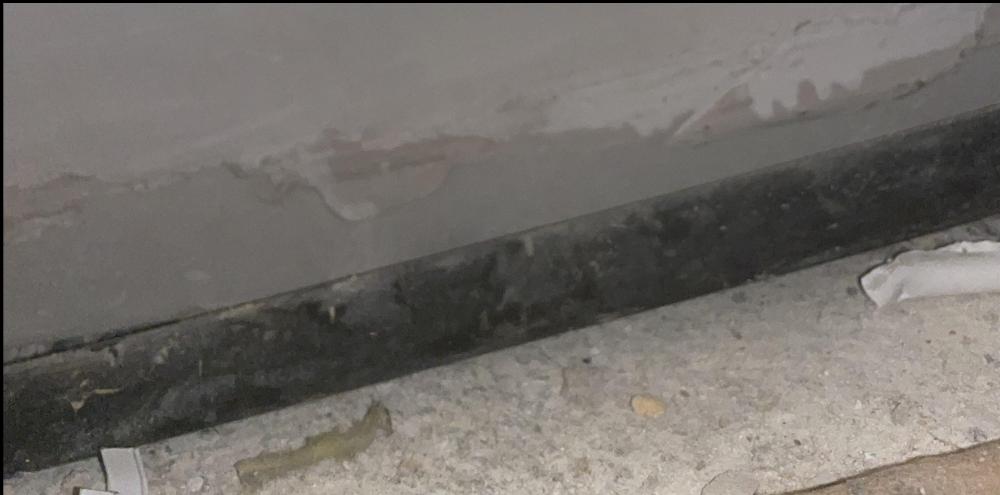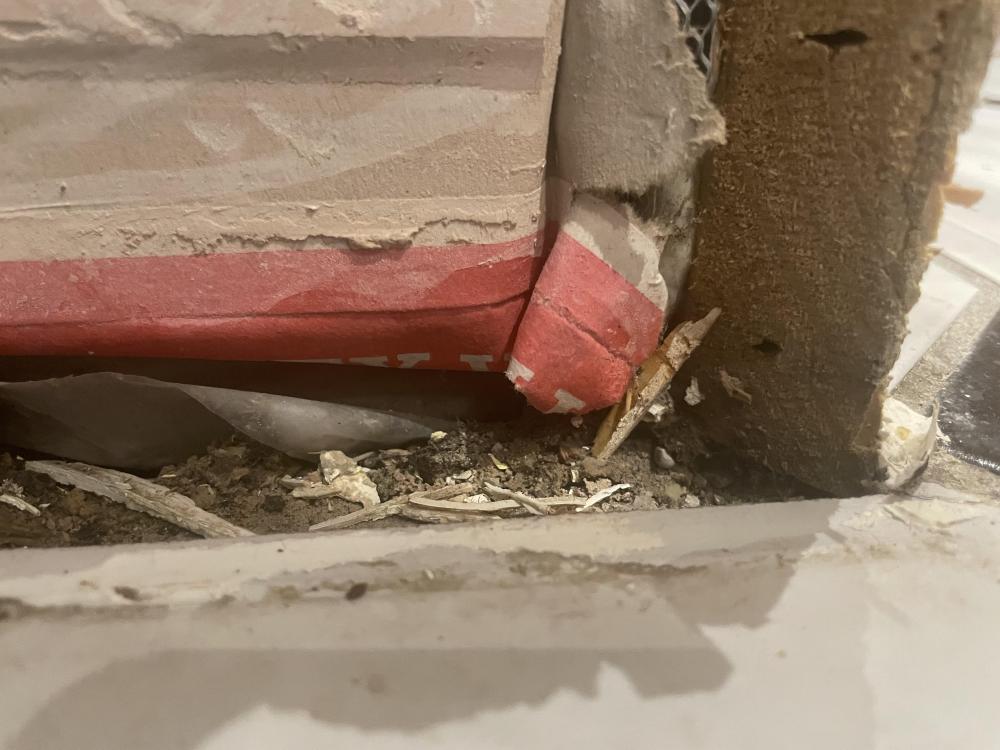
garo99
Members-
Posts
16 -
Joined
-
Last visited
Recent Profile Visitors
The recent visitors block is disabled and is not being shown to other users.
garo99's Achievements

Member (3/5)
1
Reputation
-
Thanks. Yes the floor DPC and I will take care of it before the skirting boards go back on. This is an internal wall but as you said gotta think continuity. You are also correct about insulating up to the ceiling. The kitchen is a funny room with part of it single storey and part of it under the bedrooms. I plan to get the kitchen roof sprayed and will look to make the "joins" up to the bedroom more airtight then.
-
Actually I just spoke to the builder again - he's here now - he seated the PIR blocks in something (I didn't catch what - insulation foam?) and sealed up all the joins and gaps. he's pretty confident there's no air leaks except in the area under the sink which he agreed was a potential source of an air leak and he just fixed.
-
Having said that the man who did the job commented on the poor state of the brickwork and did a good bit of repairing/sealing before the PIR boards went on.
-
I appreciate that. At this point I am looking for quick fixes and tidying up things that will be harder to do once the kitchen is complete. The floor is solid - cement over tile. I had a good look again and my guess is it's the cutouts for the pipes. This is the sink/dishwasher area which sits just under a new window - triple glazed. No bare block. Sadly too late to do much about it now.
-
Thanks all for your replies. @nodCan you expand on BLUE foam? This came up on a google search: https://www.screwfix.ie/p/soudal-soudafoam-expanding-foam-gun-grade-750ml I am looking for something that doesn't expand a lot? Or is it the brand: https://blue-60.co.uk/ @Nickfromwales Long time lurker of the MVHR forum I know what you are talking about. We got our windows redone recently and are slowly improving airtightness. The attic is a big source of heat loss and I plan to tackle that before even thinking of a blower test. This is more of an opportunistic attempt to improve what I can. As regards MVHR, I am planning to only do the upstairs bedrooms and my motivation is as much air quality as it is heat recovery. @Redbeard The boards were attached straight onto the concrete blocks. They were screwed in using some special type of screws and not a dot and dab job. This was followed by a full plaster which I am pretty happy with. The joins were pretty tight - I checked before plaster went on - and I don't think there was a perimeter bead there wasn't much room for cold air movement between the wall and the board as the boards were fixed directly on the brick and there are no battens. I only have an issue with the bottom inch on two external walls.
-
We redid our kitchen last week and I took the opportunity to get some PIR boards installed internally on all the external walls (concrete block) before the kitchen cabinets went on. When the plastering was done, the plasterer left an inch gap at the bottom (Floor is tiles on concrete) - I presumed this was customary for the skirting boards to go back on. However, I can feel a draught on the bottom of the external wall behind the sink and I presume there is some air leaking in all along the floor. Some of this is not behind kitchen cabinets so sadly out of reach but there are still sections I can get at. The worktop goes on in a week and the man who did the plastering is coming back in on Tuesday. Is there anything I can ask him to do to fix this? Airtight tape? Expanding foam? I don't think replastering the last inch is an option. I wish I had got them to plaster to the tiles at the start. I am hoping to go MVHR at some point so improving airtightness is something I want to do.
-
Thanks yes that is on the agenda but we might redo the kitchen next year so will get a new hood and everything.
-
Ah so you mean the grill and duct both below the ceiling. Yes that’s a possibility. Not as neat but a feasible option.
-
I checked and it does indeed exhaust to outside the house. The fan is mighty loud but pretty lousy as I could barely feel the air flow on the outside. Explains why cooking smells linger for longer.
-
Thanks for the reply Declan. I was not really sure how I could run the ducts down without them being a significant eyesore. But through the hot press (airing cupboard) and down into the boiler room. Now that’s an idea! Is there any problem having the ducts running close to the hot water pipes? Apart from having to be super careful not to damage them during the install process. Once in the boiler room I suppose they can be routed within the false ceiling. It is possible in theory but there are lots of unknowns...
-
I am embarrassed to admit I don’t know the answer. I did clean the whole thing and change filters summer 2018. Maybe need to do it again?
-
Mike2016 I am in a similar situation except I cannot get under the floorboards so it will have to be done from the ground floor ceiling. We redid the floors 2018 summer and that would have been a good time to put the ducting in. But hindsight is 20/20. I will probably ask for quotes next week and decide if I want a DIY upstairs only job or full house installer job. Looking at Vent Axia Sentinel Kinetic BH or Airflow Duplex Vent.
-
Thanks JFDIY. Read that one and a few others. I feel it’s a chicken and egg situation. If I improve airtightness I need an MVHR more. If I get an MCHR I need to improve airtightness more. Will never get anywhere near passive standards in this house but still would like to do all the easier cheaper improvements. On your self install, was it new build or existing. I am dreading having cut through plasterboard and running the ducts on the ground floor ceiling. There isn’t a huge amount of room and there is a mess of electrical cables.
-
Thanks PeterW. I was planning to top up the insulation in the attic space by running 200mm earthwool on top of the existing glass fibre. Planning to run it perpendicular to the joists. A quarter of the area has floor boards to cannot do anything there. And also planning to leave the area under the converted room alone. It has some insulation there which probably explains why the attic gets so cold. Ideally I would like a taped up layer of insulation running from ceiling joists to sidewalls to roof.
-
I started by trying to improve airtightness and went after perceptible drafts. Draught stripping the front door, the doors into the cold attic crawl space, the skirting boards under the bay windows. We have hole in the wall vents and I tried closing them and got insane amounts of condensation so had to open them again. But not happy with status quo as on windy days there is too much ventilation and on still days not enough. Still considering getting an MVHR. The bedrooms will be fine but routing the ducts in the downstairs rooms would be a pain. Is it worth it? The air in house is often musty and when we cook fish for instance the smell lingers in the entire house for hours despite the ancient extractor hood. The second query I have is regarding attic insulation. There is 100mm mineral wool insulation over the first floor ceiling and attic conversion in the middle with cold crawl space with full ventilation on either side. Attic room gets very cold when heat is off with temp commonly down to 10 degrees after overnight heating off. There is no roof insulation on the bare attic crawl space but polystyrene board insulation over the converted area and mineral wool on the walls. What do you suggest for improvements? I had the roof retooled last year and kicking myself now for not getting a proper insulation job at the same time.



